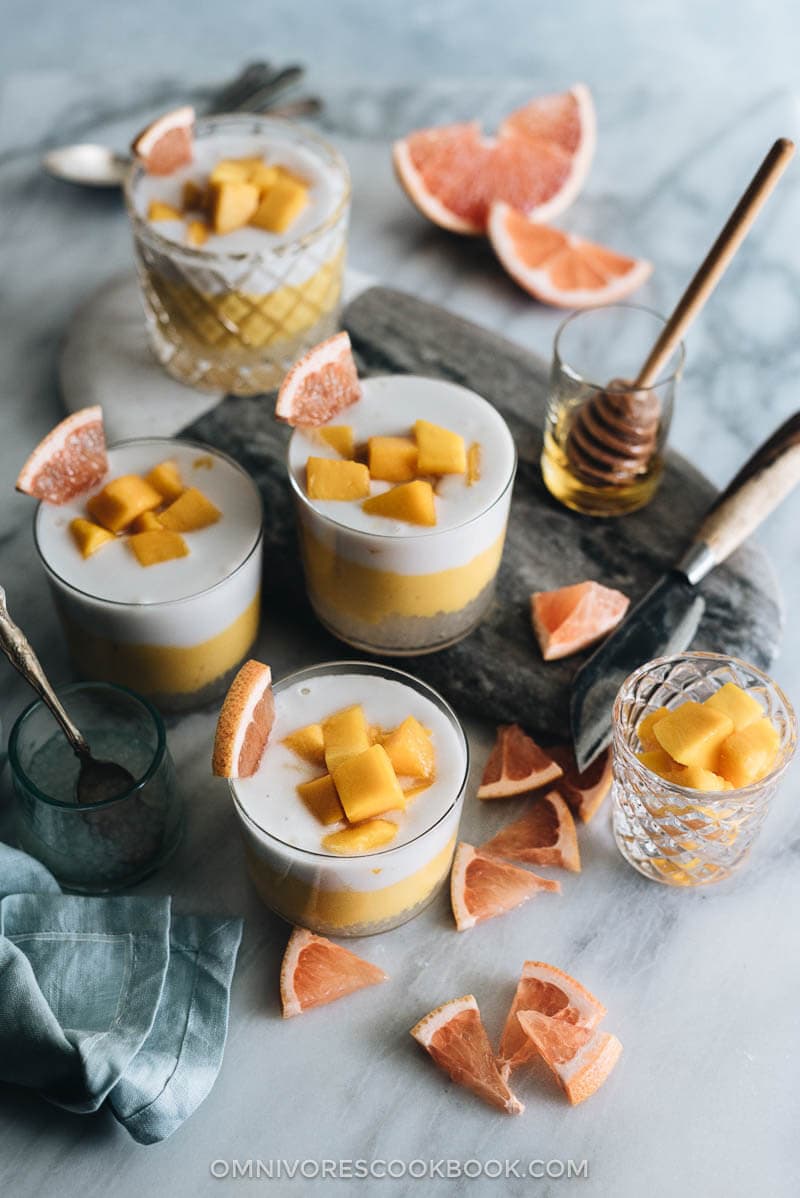
Mango sago is a popular dessert in Hong Kong and Taiwan. The first time I had this dessert was when the famous Hongkongese dessert shop Honeymoon Dessert (满记甜品) opened in Beijing. I was hooked! The sweet creamy fruity base was loaded with gooey tapioca pearls and mango chunks. It was a magical moment when I felt extremely happy after eating a spoonful of the mango sago. It immediately became my favorite summer dessert.
It never even crossed my mind to make this dish at home until I moved to the US. Now it’s a 20-minute drive to the closest Asian dessert store where I can get my sweet tooth satisfied. After a while I decided it was time to learn how to make the dish myself.
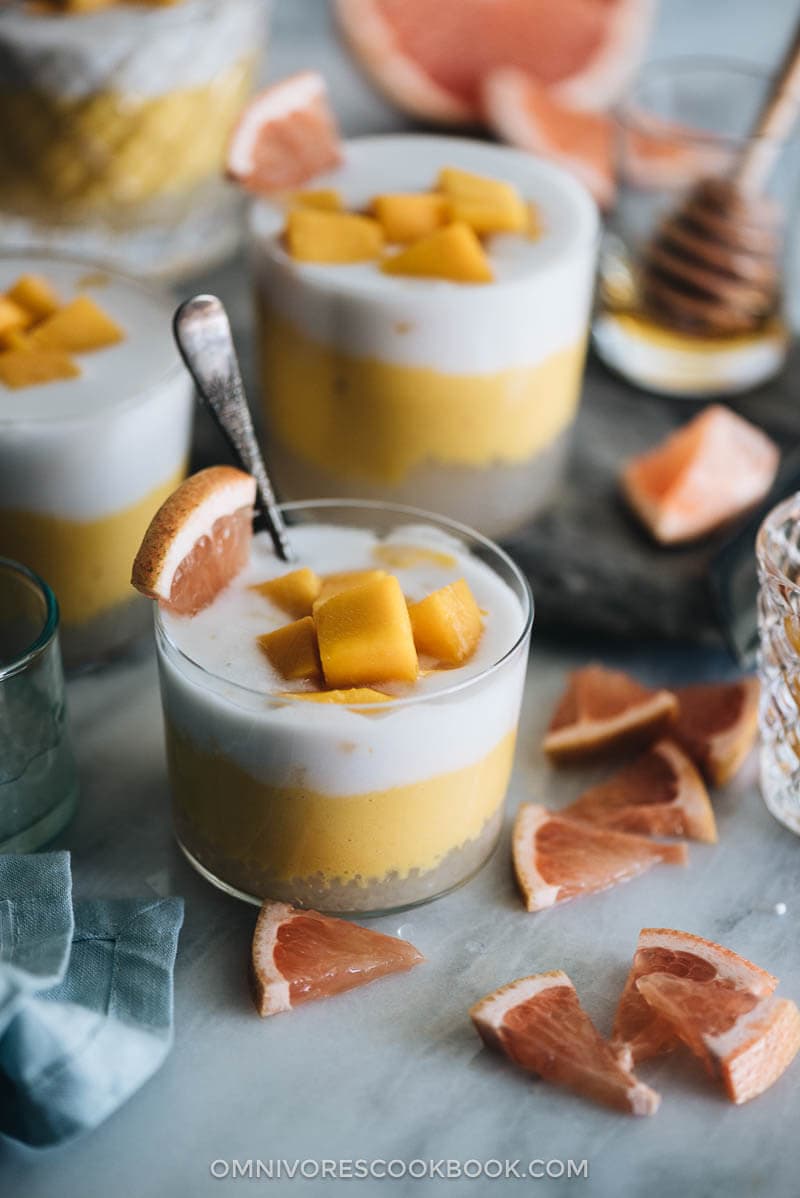
Cooking notes
1. Ingredients
Making the restaurant-style version of this dish is surprisingly easy. All you need is:
Ripe mangoes, evaporated milk, coconut milk, and small tapioca pearls.
A lot of dessert shops also use pomelo pulp in this dessert. If you cannot find pomelo, you can use grapefruit instead. You can also skip the citrus altogether.
2. How to prepare sago
The best way is to follow the instructions on the package you have, since cooking methods and times vary. Some brands recommend boiling all the way through, while others ask you to soak the tapioca pearls after boiling.
If your package does not come with instructions, simply boil them until most of the pearls turn transparent. It is OK that some of them have a small white dot in the middle. They will continue cooking a bit more when you drain them, and eventually turn completely transparent.
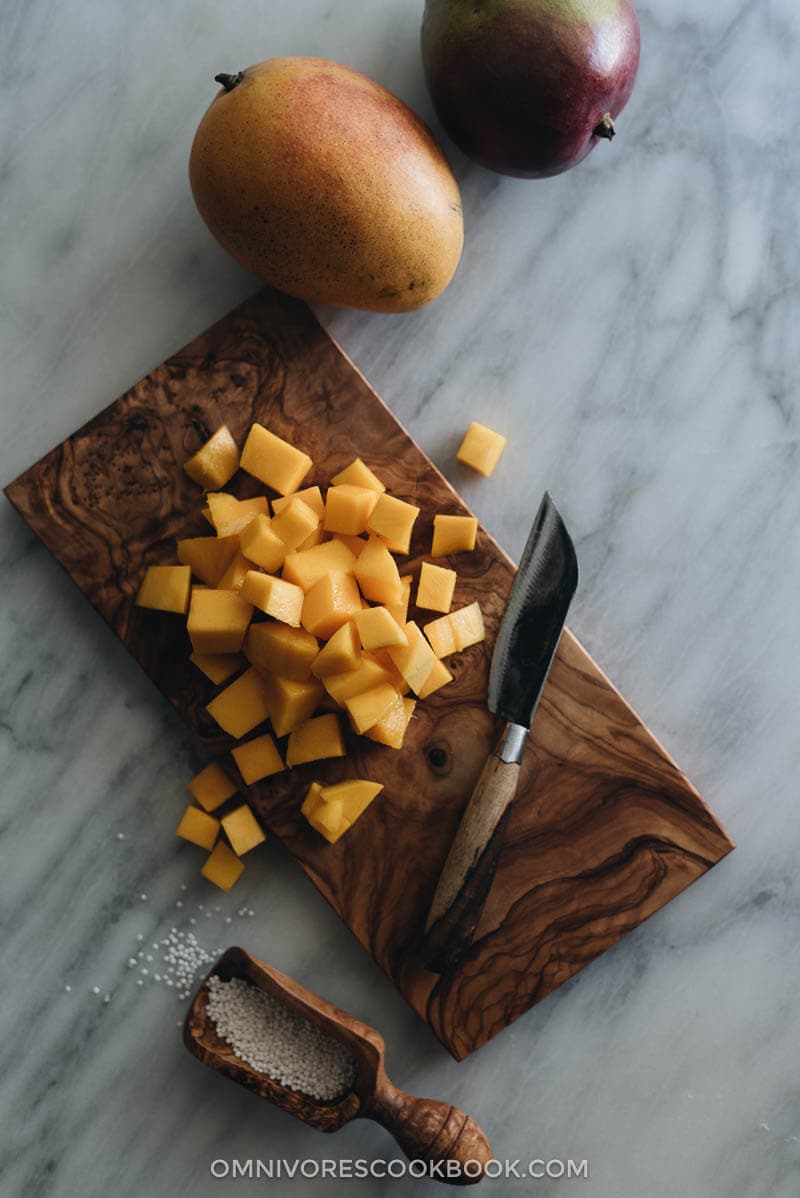
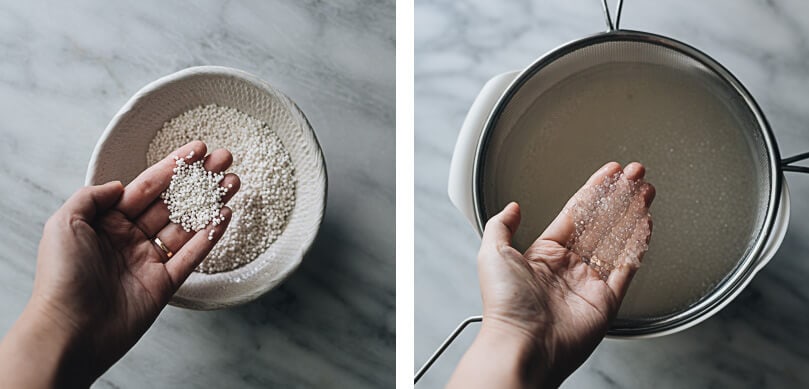
3. What type of milk to use
After trying a few recipes, I found that the combination of evaporated milk and coconut milk works best.
This recipe blends evaporated with the mango, to create a very creamy and fruity layer that is neither too runny nor too heavy. Some recipes call for condensed milk in this step, which makes the mixture too sweet. Heavy cream makes the mixture quite dense. On the other hand, milk will make the paste runny.
If you want to make the dish vegan, you can use a blend of coconut milk and plant-based milk (see the headnote in the recipe below) to create a similar texture.
The recipe finishes the dish with a top layer of coconut milk, which makes for a beautiful presentation.
4. Adjust the sweetness
I rarely need to add any sugar to my mango sago if the mangoes are very ripe. The finished product is not too sweet, which allows you to taste the original flavor of all the ingredients.
However, if you prefer a sweeter dessert, you can either add sugar into your mango paste or serve the dessert with some syrup on the side, so your guests can sweeten it as they like. Both agave syrup and coconut syrup work well.
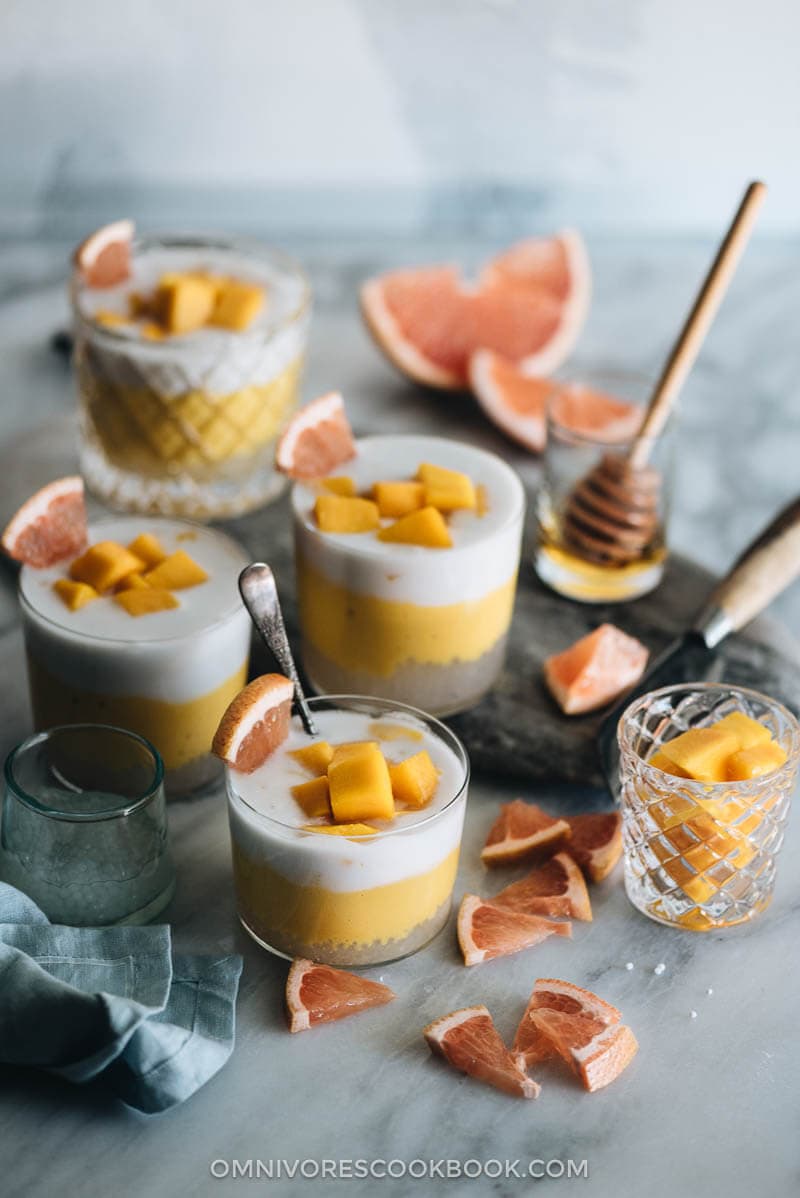
That’s it!
The last time I made a big batch of this, my husband ate three cups in one sitting because it was too irresistible! Well, since the dessert is made with all-natural ingredients and is quite low in calories, we felt no guilt even after eating too much! Now we call this homemade version of mango sago “happiness in a cup” 🙂
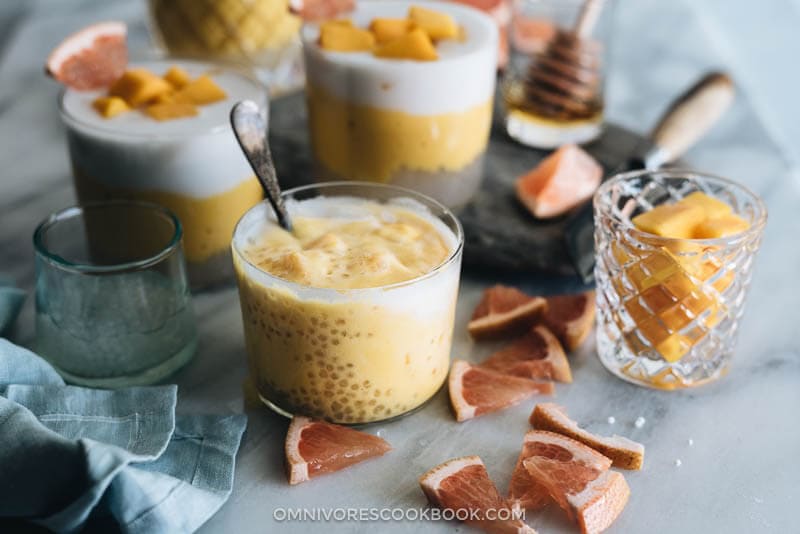
If you give this recipe a try, let us know! Leave a comment, rate it (once you’ve tried it), and take a picture and tag it @omnivorescookbook on Instagram! I’d love to see what you come up with.
Chinese Cooking Made Easy
Are you new to this website? This free email series is a great place to start. I’ll walk you through a few of my most popular recipes and show you how and why they work. You’ll quickly start to cook better Chinese food in your own kitchen.

Mango Sago (杨枝甘露)
Ingredients
- 1/4 cup (45 g) small tapioca pearls (sago)
- 2 big mangoes , peeled and diced (about 2.2 lbs/ 1kg in total)
- 3/4 cup (176 grams) evaporated milk
- 1/4 cup sugar or to taste (Optional)
- 1 cup (240 ml) full-fat coconut milk
- 1/2 grapefruit , sliced (Optional)
Instructions
- Bring 3 cups water to a boil. Add the tapioca pearls. Boil until pearls turn transparent with a small white spot in the middle of each, 12 minutes or so. Stir occasionally. (The cooking time will vary depending on the size of your tapioca pearls. You should always follow the instructions on your package if there are any.)
- Immediately strain the cooked tapioca pearls with a fine sieve and rinse them with tap water to stop the cooking. Submerge the sieve with the cooked tapioca into a bowl of tap water to prevent the pearls from drying out. Set aside.
- Add half of the mango chunks (I use the ones with imperfect shapes), about 2 cups, into a blender. Add the evaporated milk. Mix at the highest speed until it forms a smooth paste. Taste the paste. Add the sugar (if using) and blend to mix again if it’s not sweet enough.
- To assemble, divide and add the tapioca pearls into serving bowls. Top with the mango paste, then add the coconut milk. Top with the mango chunks. Garnish with grapefruit, if using. You can also chill the desserts in the fridge for an hour before serving. Enjoy!
Nutrition

Did you make this recipe?
I’d love to hear how it turned out for you! Please take a moment to leave a 5-star rating ⭐️ and share your thoughts in the comments further down the page. It really helps others discover the recipe too.

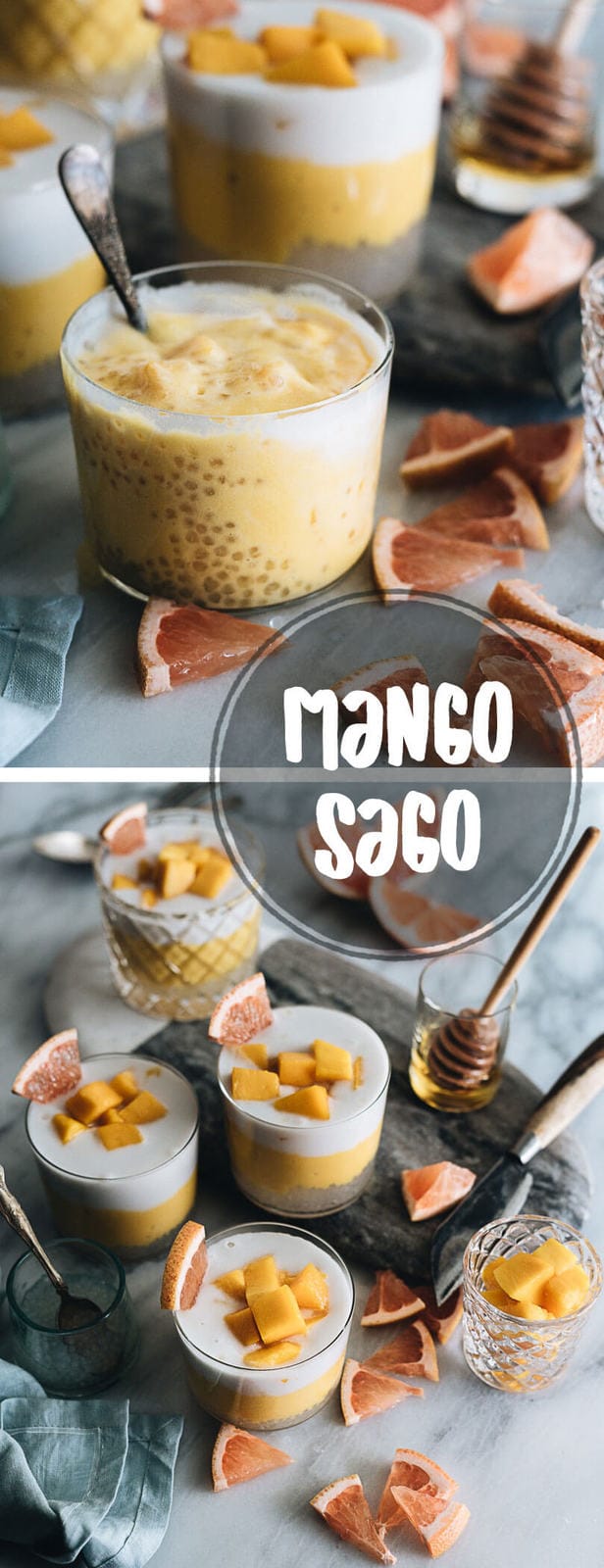
Claire w
Can you make this the night before?
Maggie Zhu
I think you can. The texture of the tapioca pearl changes a bit but it should still be tasty.
Shannon
How long does this keep in the refrigerator?
Maggie Zhu
I wouldn’t make it more than one day ahead because the tapioca will get soggy if soaked in the mango puree for too long.
Wendy
Such an easy and simple recipe to follow! I found that an hour in the fridge was not long enough. Would recommend just slightly placing the mango pieces and paste in the freezer before serving. Or you could even run some shaved iced through it, although that may unsweeten the overall taste. Otherwise , it was a crowd pleaser!! Loved it
Anton
Hi Maggie,
I’ve had this dessert in restaurants and didn’t realize it was that easy to make! Can you use frozen mango pieces?
Anton
Maggie
Hi Anton, yes you can totally use frozen mango!
Katie
Hi Maggie! I really want to make this the night before (to bring to the office next day). I was thinking of cooking the sago the night before, and bringing everything to the office separated (to assemble later during lunch time). If I do this, will the sago be ok? I’m thinking of putting it in a container with water to keep it from drying out, but do you think they will end up too soggy/mushy next day?
Maggie
Hi Katie, I think it’s OK to store the sago in cold water overnight. I also read another method about storing them in the fridge, then before you serve them, put the sago in a bowl and pour over hot water, stir to bring them back, then drain and serve. I think either way would work.
Mobeen
Hi
I really love your dish and will give it a try for my baby. I usually add mango custard to his Sogo and he love it.I hope he will love this too. I m basically from Pakistan now living in Guangzhou.
SUSAN F.
Just curious, why is it called “mango sago” when it’s made from tapioca (not the same plant)? I don’t think I could find either one, so I’ll stick to Mango sticky rice. Thanks for all the recipes.
john
Hello, I made this last night and my mother loved it! I chilled it in the fridge before serving because I thought it would be best eaten cold. Looking forward to making this again one day. Thank you for your recipes – John.
Jane
Hi, if you want to separate them into the layers as your example shows, do you need to refrigerate each layer before topping the next layer, or can you top them into three layers then do they stay in separate layers while refrigerating? The idea of layering would look pretty for a potluck!
Maggie
Hi Jane, I remember most of my ingredients were taken from the fridge, but I won’t worry too much about chilling them before preparing the dish. The tapioca pearls and the mango paste layer are quite thick, so they layers stay well separated. Although the mango chunks on top might sink a bit. Maybe you could bring the mangos in a separate container and assemble before serving.
Erica
I’ve tried this recipe. I used medium sago seeds, that’s how the bag is labelled, with no cooking instructions!
There was a choice of medium and small in the shop but I couldn’t remember which was wanted.
Would the small ones cook up to provide more to use in the serving bowl? The medium ones have made a minimal layer. Not like your picture.
Naty
Hello Maggie!
Thank you so much for sharing amazing, mouth.watering dishes.
I’ll prepare it ASAP. I have everything I need at home right now.
Thanks!!!
Mana
This sounds incredible! Thanks so much for sharing the recipe, and your history of recipes is always so fun. I feel like I’m adding to this forever long list of places to try one day if I get to make my dream visit to Asia.
I’m really looking forward to trying this one out.
Elizabeth @ Bowl of Delicious
This looks incredible! I’m always looking for light, fresh, fruity desserts once the warm weather comes- can’t wait to try 🙂